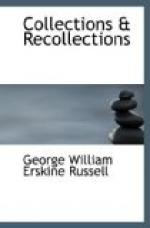Passing down through the ranks of the hierarchy, I shall presently have something to say about two or three metropolitan Canons who are notable figures in society; but before I come to them I must offer a word of affectionate tribute to the memory of Dr. Liddon. Probably there never was a man whose social habit and manner were less like what a mere outsider would have inferred from his physical aspect and public demeanour. Nature had given him the outward semblance of a foreigner and an ascetic; a life-long study of ecclesiastical rhetoric had stamped him with a mannerism which belongs peculiarly to the pulpit. But the true inwardness of the man was that of the typical John Bull—hearty, natural, full of humour, utterly free from self-consciousness. He had a healthy appetite, and was not ashamed to gratify it; liked a good glass of wine; was peculiarly fond of sociable company, whether as host or guest; and told an amusing story with incomparable zest and point. His verbal felicity was a marked feature of his conversation. His description of Archbishop Benson (revived, with strange taste, by the Saturday Review on the occasion of the Archbishop’s death) was a masterpiece of sarcastic character-drawing. The judicious Bishop Davidson and the accomplished Canon Mason were the subjects of similar pleasantries; and there was substantial truth as well as genuine fun in his letter to a friend written one dark Christmas from Amen Court: “London is just now buried under a dense fog. This is commonly attributed to Dr. Westcott having opened his study-window at Westminster.”
XVIII.
CLERGYMEN—continued.
Of the “Merriment of Parsons” one of the most conspicuous instances was to be found in the Rev. W.H. Brookfield, the “little Frank Whitestock” of Thackeray’s Curate’s Walk, and the subject of Lord Tennyson’s characteristic elegy:—
“Brooks, for they called you so that knew you best—
Old Brooks, who loved so well to mouth my rhymes,
How oft we two have heard St. Mary’s chimes!
How oft the Cantab supper host, and guest,
Would echo helpless laughter to your jest!
* * * * *
You man of humorous-melancholy mark Dead of some inward agony—is it so? Our kindlier, trustier Jaques, past away! I cannot laud this life, it looks so dark: [Greek: Skias onar]—dream of a shadow, go,— God bless you. I shall join you in a day.”
This tribute is as true in substance as it is striking in phrase. I have noticed the same peculiarity about Mr. Brookfield’s humour as about Jenny Lind’s singing. Those who had once heard it were always eager to talk about it. Ask some elderly man about the early triumphs of the Swedish Nightingale, and notice how he kindles. “Ah! Jenny Lind! Yes; there was never anything like that!” And he begins about the Figlia,




